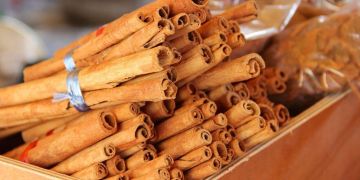Traditional use
True cinnamon, or Cinnamomum Zeylanicum, is the inner bark of a small evergreen tree native to Sri Lanka and was used in ancient Egypt for embalming. It was also added to food to prevent spoiling. During the Bubonic Plague, sponges were soaked in cinnamon and cloves and placed in sick rooms. Cinnamon was the most sought after spice during explorations of the 15th and 16th centuries.
Most therapeutic uses of Chinese cinnamon bark are rooted in its historical use as a traditional medicine and on laboratory and animal studies. Test-tube or animal research does not guarantee safety or effectiveness in humans, but German health authorities (Commission E) do approve of cinnamon bark for mild gastrointestinal spasms, stimulating appetite and relieving indigestion.
Cinnamon may help to:
Soothe an upset stomach
Cinnamon extracts have been used medically to treat gastrointestinal problems and to help calm the stomach. Cinnamon is a carminative, an agent that helps break up intestinal gas that has traditionally been used to combat diarrhea and morning sickness. Both test-tube and some animal studies have found that cinnamon may help to relieve mild abdominal discomfort caused by excess gas. It is used in flatulent dyspepsia, dyspepsia with nausea, intestinal colic and digestive atony associated with cold & debilitated conditions. It is known to relieve nausea and vomiting, and because of its mild astringency it is particularly used for infantile diarrhea.
Clear up urinary-tract infections
One German study showed that Cinnamon "suppresses completely" the cause of most urinary-tract infections (Escherichia coli bacteria) and the fungus responsible for vaginal yeast infections (Candida albicans).
Allow diabetics to use less insulin
Some studies have shown that Cinnamon helps people with diabetes metabolise sugar better. In adult-onset (Type II) diabetes, the pancreas produces insulin, but the body can't use it efficiently to break down blood sugar.
Richard Anderson at the US Department of Agriculture's Human Nutrition Research Center in Beltsville, Maryland found that Cinnamon enhances the ability of insulin to metabolise glucose, helping to control blood sugar levels. Cinnamon contains the anti-oxidant glutathione and a type of flavonoid called MHCP (methylhydroxy chalcone polymer). It is believed that cinnamon makes fat cells much more responsive to insulin, the hormone that regulates sugar metabolism and thus controls the level of glucose in the blood.
"One-eighth of a teaspoon of cinnamon triples insulin efficiency," say James A. Duke, Ph.D., a botanist retired from the U.S. Department of Agriculture and author of The CRC Handbook of Medicinal Herbs. Dr. Duke suggest that people with adult-onset diabetes discuss Cinnamon's benefits with their doctor. Taking ½ to ¾ teaspoon of ground Cinnamon with each meal may help control blood sugar levels.
Aid digestion
Cinnamon warms and stimulates the digestive system, useful in weak digestion, colic, griping, diarrhea, nausea and vomiting, wind and distension. The tannins have an astringent action, stemming bleeding in nosebleeds, heavy periods and resolving diarrhea and catarrhal congestion. Cinnamon contains compounds called catechins, which help relieve nausea. The volatile oil in cinnamon bark may also help the body to process food by breaking down fats during digestion.
Kill many disease-causing fungi and viruses
Preliminary results from test tube and animal studies suggest that cinnamon oil and cinnamon extract have anti-fungal, anti-bacterial, and anti-parasitic properties. For example, cinnamon has been found to be active against Candida albicans, the fungus responsible for vaginal yeast infections and thrush (oral yeast infection), Helicobacter pylori (the bacteria that causes stomach ulcers), and even head lice.
An incredible experiment in the journal of Food Science for 1974 demonstrated the power of cinnamon over most yeasts and fungi. Slices of white, raisin, rye and whole wheat breads, manufactured without the usual mold inhibitors, were subjected to various aflatoxins, a group of toxic molds so dangerous that they can cause liver cancer and kill humans and animals alike and often occur in food. The toxic molds grew vigorously on all of the other breads, except for the raisin bread where growth was described as being "scant or not visible at all." In trying to identify whether it was the raisins or cinnamon responsible for this, food scientists discovered that as little as 2% or 20 mg. of the spice per ml of a yeast-extract and sucrose broth inhibited 97 -99 per cent of these molds.
Relieve Pain
Cinnamon is considered a pain-killer due to its prostaglandin-inhibiting action.
Relieve Colds and Flu
In both India and Europe, cinnamon has been traditionally taken as a warming herb for "cold" conditions, often in combination with ginger (Zingiber officinale). The herb stimulates circulation, especially to the fingers and toes and has been used for arthritis. Cinnamon is also a traditional remedy for aching muscles and other symptoms of viral conditions such as colds and flu.





